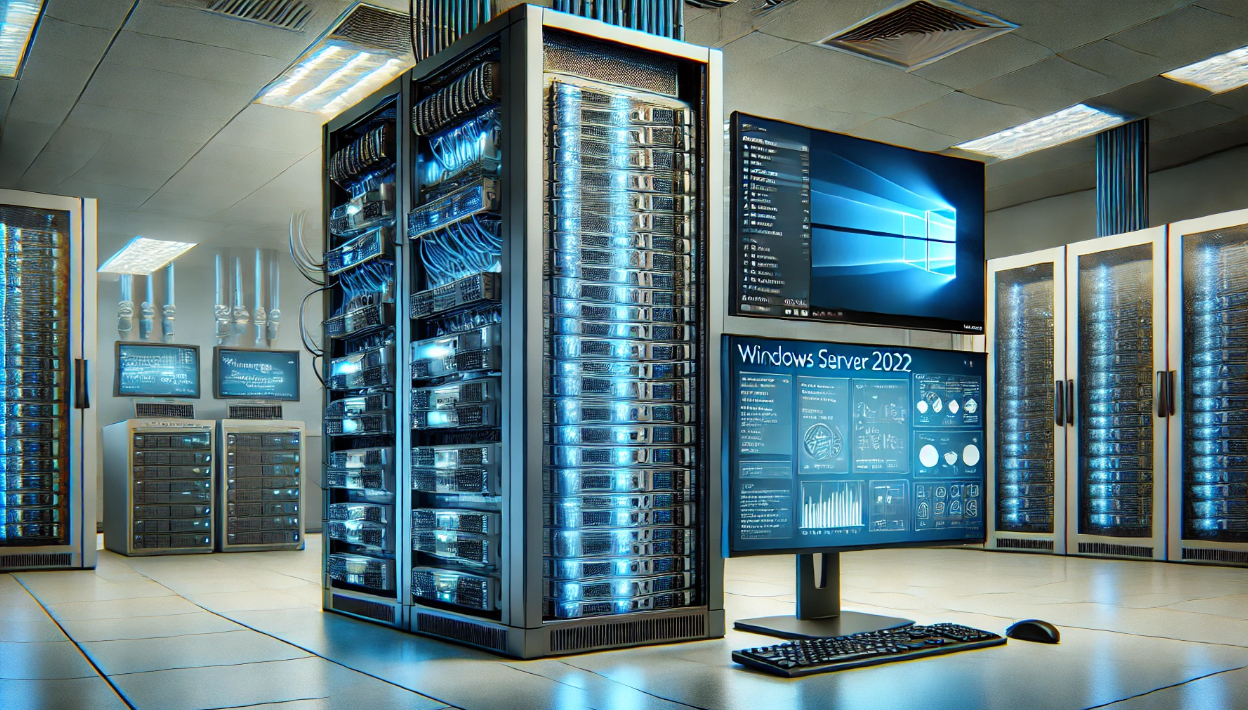Step-by-Step Guide to Installing and Configuring Windows Server 2022
Windows Server 2022 is the latest enterprise-grade operating system from Microsoft, offering enhanced security, hybrid cloud capabilities, and better performance. Whether you’re setting up a domain controller, file server, or remote desktop server, proper installation and configuration are crucial.
✅ In this guide, we’ll cover:
- ️ System Requirements for Windows Server 2022
- How to Download & Create a Bootable USB
- ⚙️ Step-by-Step Installation Process
- Post-Installation Configurations
Let’s get started!
System Requirements for Windows Server 2022
Before installing, ensure your system meets the minimum hardware requirements:
| Component | Minimum Requirement | Recommended |
|---|---|---|
| Processor | 1.4 GHz 64-bit | 2+ GHz, Multi-Core |
| RAM | 2 GB (Desktop), 512 MB (Core) | 8+ GB |
| Storage | 32 GB | 100+ GB |
| Network | 1x Ethernet Adapter | Gigabit Adapter |
Pro Tip: Use SSD storage for faster performance and better disk I/O speeds.
Step 1: Download & Create a Bootable USB
✅ 1. Download Windows Server 2022 ISO
- Visit the official Microsoft Evaluation Center.
- Select Windows Server 2022 ISO and download it.
- Save it to your local drive.
✅ 2. Create a Bootable USB Drive
Use Rufus or Windows Media Creation Tool to create a bootable USB:
- Insert a USB drive (8GB+ recommended).
- Open Rufus and select:
- Device: Your USB
- Boot Selection: Browse & select the ISO file
- Partition Scheme: GPT (for UEFI) or MBR (for Legacy BIOS)
- Click Start and wait for the process to complete.
Pro Tip: Use UEFI mode for modern servers, as it improves security and performance.
Step 2: Install Windows Server 2022
✅ 1. Boot from the USB Drive
- Insert the bootable USB into the target server.
- Restart and enter BIOS/UEFI (F2, F12, DEL, ESC, or F10).
- Set the USB drive as the first boot device.
- Save changes and restart.
✅ 2. Start the Windows Server Installation
- Once the Windows Setup loads, select:
- Language → English (or your preference)
- Time & currency format → Your region
- Keyboard input method → US or preferred layout
- Click Next → Install Now.
✅ 3. Enter Product Key or Choose Trial Version
- Enter your Windows Server 2022 license key, or
- Click “I don’t have a product key” for a trial installation (180 days).
✅ 4. Choose the Windows Server Edition
Select one of the available editions:
| Edition | Best For |
|---|---|
| Windows Server 2022 Standard | Small & mid-size businesses |
| Windows Server 2022 Datacenter | Enterprise with virtualization needs |
| Windows Server 2022 Datacenter: Azure Edition | Cloud-based hybrid environments |
| Windows Server 2022 Core | Minimal installation for performance & security |
Pro Tip: The Desktop Experience version includes a GUI, while Server Core is command-line only.
✅ 5. Select Installation Type
- Upgrade → If upgrading from Windows Server 2019/2016.
- Custom (Clean Install) → For a fresh installation (recommended).
Pro Tip: A clean install ensures better stability & performance.
✅ 6. Choose the Installation Drive
- Select the drive where Windows Server 2022 will be installed.
- Click New → Apply → OK to create partitions.
- Click Next to start the installation.
Pro Tip: If using RAID storage, configure it in BIOS before installation.
✅ 7. Complete the Installation
- The server will restart multiple times.
- Once finished, set an Administrator password.
- Click Finish to log into Windows Server 2022.
️ Step 3: Post-Installation Configuration
Once Windows Server 2022 is installed, follow these essential configurations:
✅ 1. Change the Computer Name & Set Time Zone
- Open Server Manager → Click Local Server.
- Click Computer Name → Change it to your preferred name.
- Set the correct Time Zone.
Pro Tip: Use a descriptive hostname like DC-01 for a Domain Controller or SQL-SERVER for a database server.
✅ 2. Enable Remote Desktop (RDP) & Firewall Settings
- Go to Server Manager → Local Server.
- Click Remote Desktop → Enable.
- Configure Firewall Rules to allow RDP access.
Pro Tip: For security, allow RDP only from specific IP addresses.
✅ 3. Install Roles & Features
Windows Server allows multiple roles, such as:
| Feature | Purpose |
|---|---|
| Active Directory Domain Services (AD DS) | Set up a domain controller |
| DNS & DHCP Server | Manage network services |
| File & Storage Services | Manage shared folders and storage |
| Remote Desktop Services (RDS) | Enable remote access |
| Hyper-V | Create and manage virtual machines |
- Open Server Manager → Click Add Roles and Features.
- Choose the necessary roles.
- Complete the setup.
Pro Tip: If configuring Active Directory, install AD DS first before adding users & groups.
✅ 4. Install Windows Updates & Security Patches
- Go to Settings → Update & Security → Check for Updates.
- Install all critical updates to ensure security.
Pro Tip: Enable automatic updates to receive the latest security patches.
✅ 5. Configure Networking (Static IP & DNS)
- Go to Control Panel → Network & Internet → Network Connections.
- Select Ethernet Adapter → Right-click → Properties.
- Choose Internet Protocol Version 4 (TCP/IPv4) → Set Static IP, Subnet, Gateway, and DNS.
Example Static IP Configuration:
- IP Address: 192.168.1.100
- Subnet Mask: 255.255.255.0
- Gateway: 192.168.1.1
- DNS: 8.8.8.8 (Google)
Final Thoughts: Why Upgrade to Windows Server 2022?
✅ Key Benefits:
✔️ Better Security – Advanced Secured-Core Protection.
✔️ Cloud-Ready Features – Azure Hybrid Integration.
✔️ Faster Performance – Optimized for Intel Ice Lake & AMD EPYC processors.
✔️ Improved Storage & Virtualization – Better Hyper-V support.
By following this step-by-step guide, you can successfully install and configure Windows Server 2022 for enterprise-grade performance!

